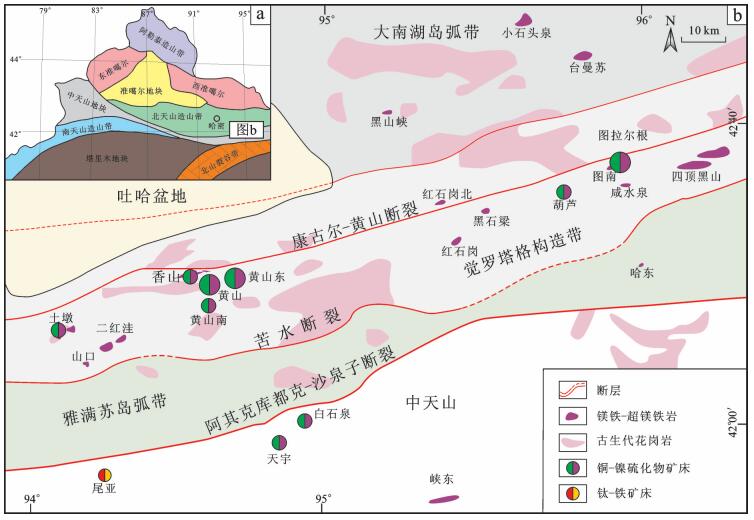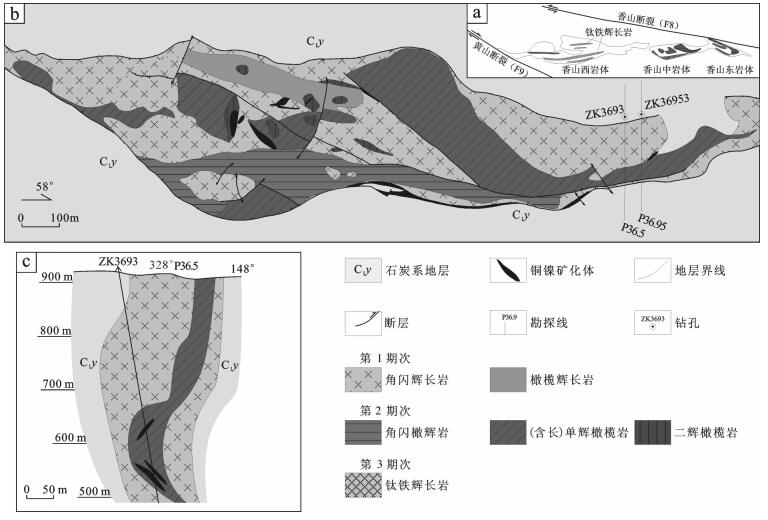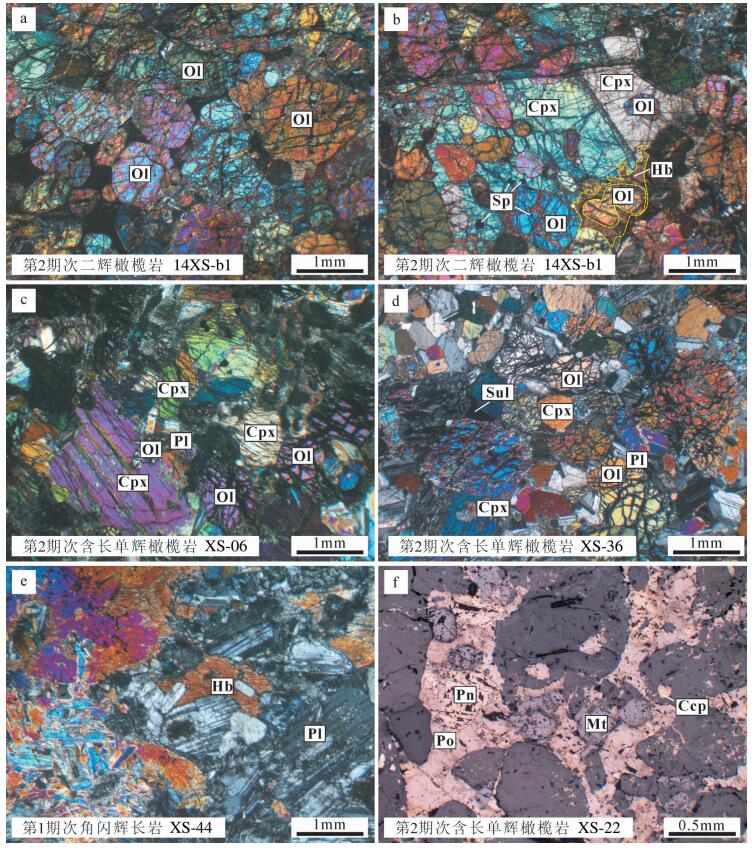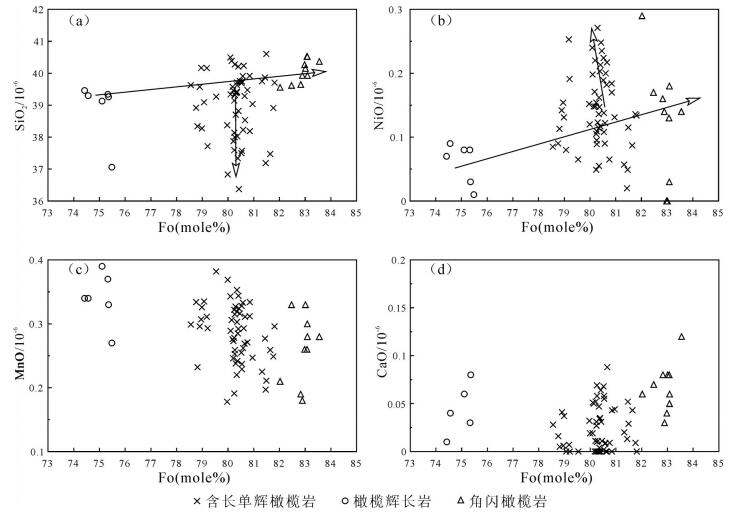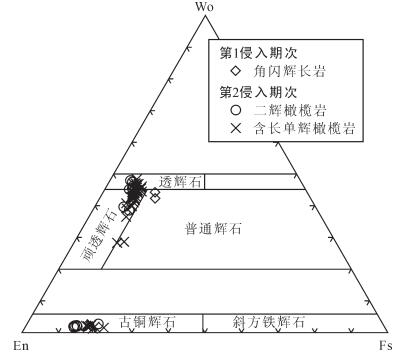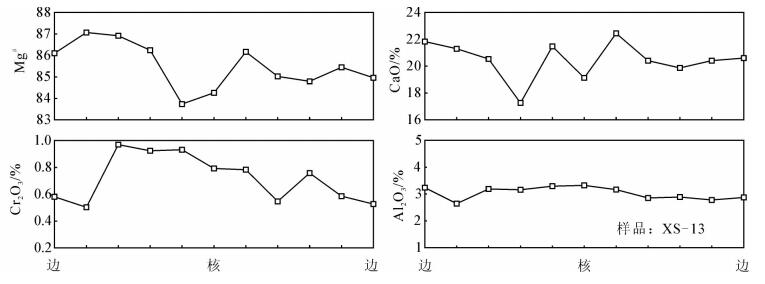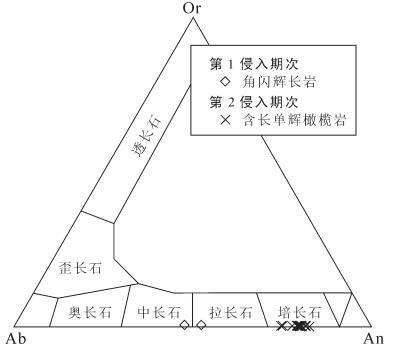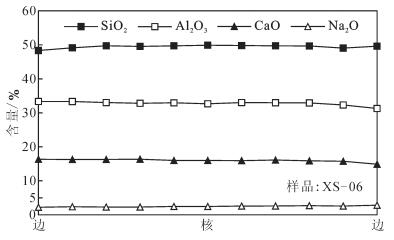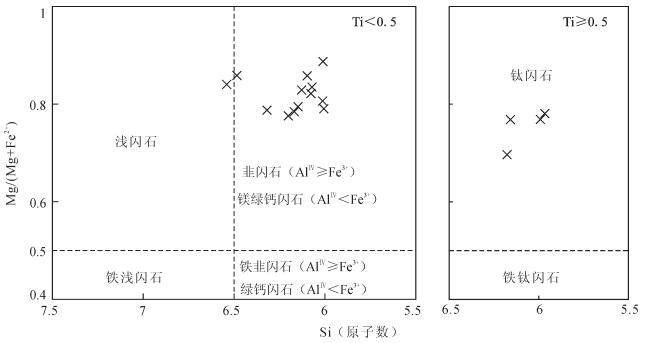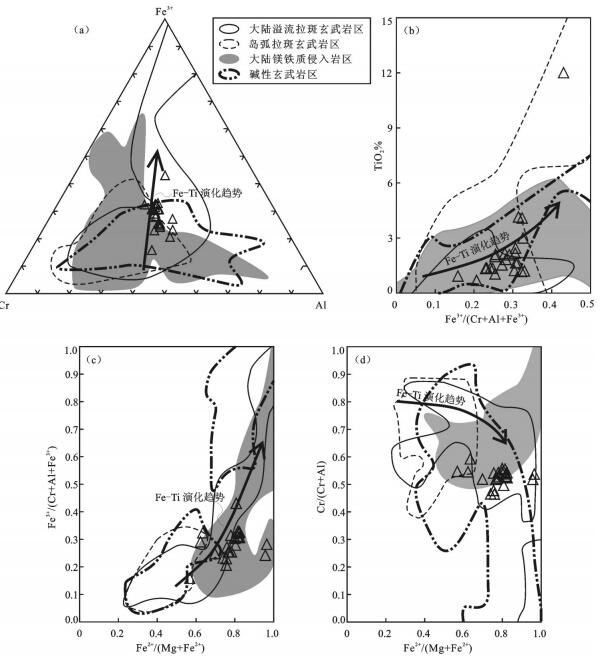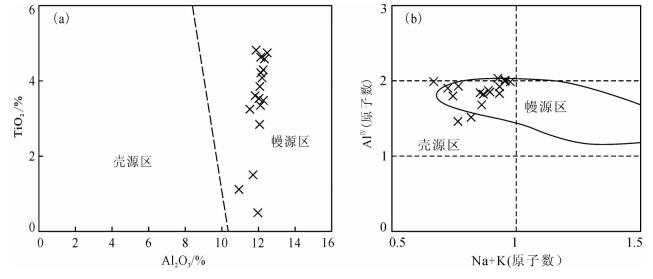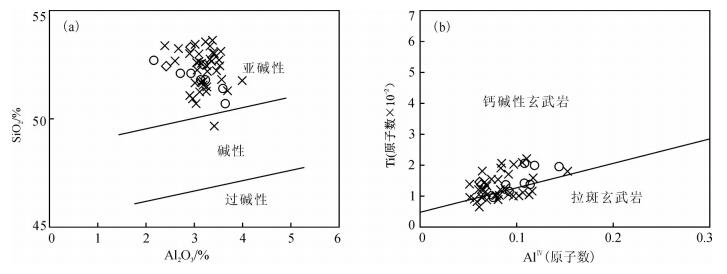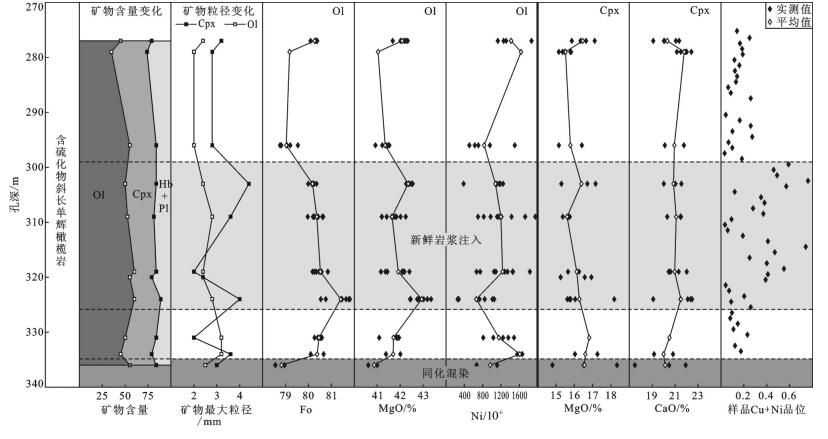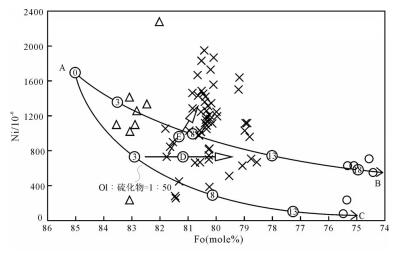Petrological and mineralogical characteristics of the Xiangshanzhong maficultramafic intrusion in eastern Tianshan Mountains: Constrains on rockforming and ore-forming processes
-
摘要:
香山中镁铁-超镁铁岩体产出于新疆东天山地区的黄山—镜儿泉镁铁-超镁铁岩带。主要的岩石类型为二辉橄榄岩、(含长)单辉橄榄岩、橄榄辉石岩及角闪辉长岩。矿物学特征显示,岩体造岩矿物的结晶顺序为铬尖晶石→橄榄石→斜方辉石→单斜辉石→斜长石→角闪石。电子探针分析显示,同一侵入期次中各岩相具有良好的过渡渐变关系,钻孔剖面上橄榄石含量与颗粒大小、单斜辉石的成分有随深度连续变化的特征,铬尖晶石则具有良好的Cr→Fe3+、Ti的演化趋势,由此反映岩体的形成主要受结晶分异作用的控制;含长单辉橄榄岩中橄榄石和单斜辉石成分的突然变化显示岩浆结晶过程中受到了地壳物质阶段性的混染;模拟计算表明,橄榄石分离结晶伴随着硫化物的熔离;钻孔ZK3693深度为295~325 m,含长单辉橄榄岩中橄榄石、斜长石、单颗粒单斜辉石成分突然性的变化指示在区间内有新鲜的基性程度更高的岩浆注入,而此区间内矿石的Cu、Ni品位明显高于区间外同一岩相岩体,说明新鲜岩浆的注入是香山中岩体硫化物富集的重要原因。
Abstract:Mafic-ultramafic rocks in Xiangshan are located in Huangshan-Jingerquan mafic-ultramafic rock zone in east Tianshan Mountains, Xinjiang. The main rock types are iherzolite, (containing feldspar) clinopyroxene peridotite, olivine pyroxenite and hornblende gabbro. According to the mineralogical characteristics, the rock mineral crystallization sequence is in order of chrome spinel, olivine, orthopyroxene, clinopyroxene, plagioclase, and angle amphibole. In the same period, the transition of the lithofacies in each stage of the invasion period has a good transition. The content of olivine in the drilling section and the composition of the particles and the composition of the particles in the drilling section vary with depth. The evolution of Cr→Fe3+, Ti in picotite is good. According to these features, the formation of the rock mass is mainly controlled by the crystallization differentiation. Abrupt change of olivine and the composition of the olivine in the (feldspar-bearing) clinopyroxene show the existence of crustal mixture in the process of magma crystallization. The simulation results show that the crystallization of olivine was accompanied by the melting of the sulfide. At the depths of 295-325 m in ZK3693 borehole, abrupt change of the composition of (feldspar-bearing) clinopyroxene in the olivine, plagioclase, single grain clino-feldspar and the Al→Cr evolution of the Cr spinel indicates that there is a higher basic level of magma injection in the interval. The Cu and Ni grades of the ore in this area are obviously higher than those of the same rock mass which is not in the interval. That injection of fresh magma is an important cause of the sulfide enrichment in Xiangshan.
-
1. 引言
遥感地质找矿是遥感信息获取、含矿信息提取以及含矿信息成矿分析与应用的过程, 近年来, 被广泛应用于地质、矿产资源及相关环境的调查中(刘燕君等, 1993; 朱振海, 1994; 郭德方, 1995; Sabins, 1999; Everett et al., 2002; 廖崇高等, 2002; 连长云等, 2005; 刘颖璠等, 2012; 钱建平等, 2012; 谭克龙等, 2012; 杜小弟等, 2015)。航空高光谱是当前遥感的前沿技术, 通过高光谱成像所获取的地球表面的图像包含光谱维信息融合为一体, 即“图谱合一” (束炯等, 2006), 具有波段数多, 波带窄, 对地物能定量分析等优点, 是20世纪末期以来遥感领域最大的技术进展(Campbell et al., 2011)。航空高光谱遥感技术相对于星载高光谱遥感技术, 可以获取高空间分辨率的高光谱遥感数据, 因而对微小地物具有更强的识别能力(刘德长等, 2015)。通过高光谱矿物填图, 可以大面积、快速提取蚀变矿物(Clack et al., 1990)。王润生等(2010)系统总结了高光谱矿物填图技术流程、工作方法和技术体系。中国国土资源航空物探遥感中心在新疆土屋东—三岔口地区, 应用HyMap航空成像光谱数据填绘出了白云母、绿泥石、绿帘石、绿泥石和绿帘石组合、高岭石、蒙脱石、透辉石、透闪石、蛇纹石、褐铁矿、方解石等矿物或矿物组合种类(王润生等, 2011)。
本文以新疆卡拉塔格地区获取的HyMap航空高光谱数据、地面准同步定标数据、地面高光谱数据为例, 提取并筛选了基于HyMap航空高光谱影像的成矿有利蚀变信息, 在此基础上对红山铜金矿床航空-地面高光谱提取的蚀变信息进行了综合剖析, 并结合矿区地质背景, 建立了红山铜金矿床高光谱遥感地空综合找矿模型, 圈定了2处找矿有利地段。
2. 研究区地质概况
研究区大地构造位于东天山吐哈盆地南缘、大南湖—头苏泉晚古生代岛弧带(图 1)。
![]() 图 1 新疆卡拉塔格地区地质矿产图1—全新统:砂石及砾石沉积; 2—下侏罗统三工河组:粉砂质泥岩、泥质砂岩夹钙质砂岩; 3—上二叠统库莱组:砾岩、中粗粒岩屑砂岩; 4—中二叠统阿尔巴萨依组:凝灰岩、橄榄玄武岩; 5—上石炭统脐山组:玄武岩、安山岩; 6—下泥盆统大南湖组:安山岩、英安岩、熔结凝灰岩、火山角砾岩; 7—中—上志留统红柳峡组:凝灰质砾岩、晶屑岩屑凝灰岩; 8—中奥陶统荒草坡群大柳沟组:玄武岩、安山岩、英安岩; 9—志留纪二长花岗岩; 10—志留纪花岗闪长岩; 11—志留纪英云闪长岩; 12—花岗岩体; 13—地质界线; 14—角度不整合界线; 15—岩相界线; 16—逆断层; 17—性质不明断层; 18—推测断层; 19—铜金矿; 20—铜锌矿; 21—铜锌金矿; 22—铜铁矿Figure 1. Geological map of Kalatag area in Xinjiang1-Holocene, sand and gravel deposits; 2-Lower Jurassic Sangonghe Formation: river silty mudstone, argillaceous sandstone intercalated with calcareous sandstone; 3-Permian Kulai Formation: breccia, coarse grained lithic sandstone; 4-Middle Permian Aebasayi Formation: tuff, olivine basalt; 5-Carboniferous Qishan Formation: basalt, andesite; 6-Lower Devonian Dananhu Formation: andesite, dacite, welded tuff and volcanic breccia; 7-Middle-upper Silurian Hongliuxia Formation: tuffaceous conglomerate, wafer crumbs debris tuff; 8-Daliugou Formation of Ordovician Huangcaopo Group: basalt, andesite, dacite; 9-Silurian monzonitic granite; 10-Silurian granite diorite; 11-Silurian tonalite; 12-Granite rock mass; 13-Geological boundary; 14-Angular unconformity; 15-Petrofacies boundary; 16-Thrust; 17-Unknown fault; 18-Inferred fault; 19-Copper and gold deposit; 20-Copper and zinc deposit; 21-Copper zinc deposit; 22-copper deposit
图 1 新疆卡拉塔格地区地质矿产图1—全新统:砂石及砾石沉积; 2—下侏罗统三工河组:粉砂质泥岩、泥质砂岩夹钙质砂岩; 3—上二叠统库莱组:砾岩、中粗粒岩屑砂岩; 4—中二叠统阿尔巴萨依组:凝灰岩、橄榄玄武岩; 5—上石炭统脐山组:玄武岩、安山岩; 6—下泥盆统大南湖组:安山岩、英安岩、熔结凝灰岩、火山角砾岩; 7—中—上志留统红柳峡组:凝灰质砾岩、晶屑岩屑凝灰岩; 8—中奥陶统荒草坡群大柳沟组:玄武岩、安山岩、英安岩; 9—志留纪二长花岗岩; 10—志留纪花岗闪长岩; 11—志留纪英云闪长岩; 12—花岗岩体; 13—地质界线; 14—角度不整合界线; 15—岩相界线; 16—逆断层; 17—性质不明断层; 18—推测断层; 19—铜金矿; 20—铜锌矿; 21—铜锌金矿; 22—铜铁矿Figure 1. Geological map of Kalatag area in Xinjiang1-Holocene, sand and gravel deposits; 2-Lower Jurassic Sangonghe Formation: river silty mudstone, argillaceous sandstone intercalated with calcareous sandstone; 3-Permian Kulai Formation: breccia, coarse grained lithic sandstone; 4-Middle Permian Aebasayi Formation: tuff, olivine basalt; 5-Carboniferous Qishan Formation: basalt, andesite; 6-Lower Devonian Dananhu Formation: andesite, dacite, welded tuff and volcanic breccia; 7-Middle-upper Silurian Hongliuxia Formation: tuffaceous conglomerate, wafer crumbs debris tuff; 8-Daliugou Formation of Ordovician Huangcaopo Group: basalt, andesite, dacite; 9-Silurian monzonitic granite; 10-Silurian granite diorite; 11-Silurian tonalite; 12-Granite rock mass; 13-Geological boundary; 14-Angular unconformity; 15-Petrofacies boundary; 16-Thrust; 17-Unknown fault; 18-Inferred fault; 19-Copper and gold deposit; 20-Copper and zinc deposit; 21-Copper zinc deposit; 22-copper deposit区内地层整体呈北西向产出, 由中奥陶统荒草坡群大柳沟组(O2Hd)、中—上志留统红柳峡组(S2-3h)、下泥盆统大南湖组(D1d)、上石炭统脐山组(C2qs)、中二叠统阿尔巴萨依组(P2a)、上二叠统库莱组(P3k)、下侏罗统三工河组(J1s)、全新统(Qh)组成。
该区经历了多期次的构造变动, 区域构造形成类型多样、特征复杂, 褶皱、断裂和火山机构发育, 区域性的断裂构造控制着该区火山岩和侵入岩的展布, 次级断裂控制着矿化蚀变带的分布, 更次一级构造裂隙带控制着矿化体的产出。主要发育北西、北北西和北东东向三组断裂构造, 其中北西向断裂为该区主要控矿构造, 同火山断裂发育, 含矿火山热液沿断裂活动强烈。
区内火山活动强烈, 火山岩分布广泛。岩石类型以中基性火山岩为主, 中酸性火山岩次之, 从奥陶系至二叠系均有出露, 其中奥陶系最为发育, 其次为泥盆系、石炭系, 二叠系局部出现。侵入岩较为发育, 主要为一套古生代侵入体, 包括中酸性闪长岩、花岗闪长岩、花岗岩等侵入岩, 中部为与铜金矿化直接相关的中生代中酸性火山机构, 主要由石英斑岩、钠长斑岩、英安岩、英安斑岩、安山玢岩、闪长玢岩和火山角砾集块岩等岩性构成。其中志留纪侵入岩由老到新依次为英云闪长岩、花岗闪长岩、二长花岗岩、花岗斑岩。该区经受了区域埋深变质作用, 变质程度较弱, 主要变质矿物为绿泥石、钠长石、葡萄石、石英、阳起石、方解石、绿帘石。
区内已知矿床自北西向南东依次产出有:红山铜金矿床→梅岭铜锌金矿床→红石铜金矿床→红海铜锌金矿床。
3. 高光谱遥感地空综合预测方法用于寻找铜金矿床的原理
3.1 高光谱遥感地空综合预测方法的依据
不同矿床类型由于岩石岩性和蚀变矿物不同, 它们的光谱特征有明显的差异(姚佛军, 2006)。铜金矿床属于内生金属矿床, 这类矿床与地表蚀变密切相关, 可以利用航空高光谱遥感影像进行蚀变矿物提取, 结合地表岩石光谱测试分析, 应用HyMap航空成像光谱仪和美国ASD公司的FieldSpec Pro FR光谱仪对不同类型矿床的光谱特征进行测量, 分析其不同类型矿床的光谱特征, 进行蚀变矿物遥感信息提取, 开展高光谱遥感地空综合预测研究, 进而指导找矿。
3.2 蚀变矿物诊断性光谱特征分析
岩矿的光谱包含有一系列特征吸收谱带。每一个特征谱带或谱带组合与岩矿内部微粒的物质属性存在一定的对应关系(Povarennykh, 1978)。在短波红外光谱区域, 褐铁矿、黄钾铁矾、白云母、绿泥石等具有可以识别的诊断性光谱特征, 特征吸收波段的深度与岩石中这些矿物的含量密切相关(刘圣伟, 2006)。矿物诊断性光谱吸收包括金属阳离子在可见光区域的电子过程以及阴离子基团在近红外区域的振动过程。蚀变矿物的可见光−近红外范围内几种官能团主要包括Fe2+、Fe3+、Al−OH、Mg−OH、OH-、CO32-。
一般阴离子诊断谱带位于2000~2500 nm光谱区域。而Fe2+、Fe3+和Mn2+诊断谱带一般位于400~1200 nm光谱区域(甘甫平等, 2003)。所以根据400~1100 nm光谱区间的Fe吸收谱带和2000~2500 nm羟基和碳酸根谱带将矿物分为含铁矿物、含羟基矿物和含碳酸根矿物以及其他矿物(甘甫平, 2003)。褐铁矿的光谱吸收谷是矿物光谱分析、遥感铁染异常提取常用的波段。其中Fe3+离子的特征吸收谷位主要在600~800 nm, 中心位置在700 nm左右, Fe2+离子的特征吸收谷位主要在900~1500 nm, 中心位置在1200 nm左右; 白云母的诊断性光谱特征是Al−OH键在2180~2230 nm之间的尖锐而深的吸收特征, 以及在2340 nm和2440 nm附近的较弱Al−OH特征, Clark et al.(1990)在高光谱分辨率下, 检测到白云母矿物在2200 nm附近的吸收波段随Al含量的增加向长波方向的移动; 绿泥石的光谱具有Fe−OH和Mg−OH的诊断性吸收特征, 波长位置分别为2235~2255 nm和2320~2360 nm, 这些吸收特征的波长随着绿泥石中铁离子含量的增加而增大。
4. HyMap航空高光谱数据获取及处理
综合考虑仪器参数、成图精度的要求、研究区自然地理、地形起伏、野外工作条件等因素, 进行飞行方案的最优设计(表 1)。将HyMap成像光谱仪搭载在Y−12飞机上, 利用国外引进的HyMap航空高光谱遥感测量系统、地面ASD光谱测量系统。采集高光谱分辨率的HyMap航空高光谱遥感数据、地面准同步的地物光谱定标数据。具体获取过程分为3个步骤:首先对HyMap成像光谱仪进行实验室定标, 保证其性能指标达到项目要求, 以获取优质的高光谱影像数据; 其次进行HyMap仪器的安装和测试, 按照仪器安装规范方法, 将HyMap安装在Y−12飞机上, 保证机下的摄影窗口满足数据获取要求, 按照航空成像光谱数据获取规范进行地面测试; 最后为HyMap航空高光谱数据获取和初步质量检查。
表 1 HyMap航空成像光谱仪主要技术参数Table 1. Main technical parameters of HyMap aviation imaging spectroradiometer
在此基础上, 开展HyMap航空高光谱遥感数据辐射定标、大气校正光谱反演、几何校正和地理编码等数据处理工作。通过此项研究, 为高光谱遥感地空综合预测铜金矿床的技术方法研究和应用提供可靠的数据基础。
5. 地面高光谱数据获取及处理
地面光谱测量采用美国ASD公司生产的FieldSpec Pro FR地面光谱测量仪(表 2)。利用该仪器开展了地面光谱准同步定标。在HyMap高光谱数据获取过程中, 准同步布设黑白布定标场和明暗地物定标场, 利用FieldSpec Pro FR地面光谱测量仪进行光谱定标数据获取(图 2,图 3), 并基于经验线性模型法, 对高光谱影像进行大气校正和光谱比对分析。
表 2 FieldSpec Pro FR光谱仪主要技术参数Table 2. Main technical parameters of FieldSpec Pro FR spectrometer
同时开展了典型铜金矿床地表蚀变围岩和其他相关的岩石地物的光谱测量, 完成了4条贯穿地层走向的成矿有利地质单元光谱测量和4条典型矿床光谱测量。共完成光谱测量点287个, 光谱测量曲线2870条。测量完成后, 开展了各岩石类型的岩矿光谱数据处理、光谱库建立、光谱特征分析等研究工作, 研究及分析结果为航空高光谱蚀变矿物信息提取、地面光谱验证、铜金矿床围岩蚀变信息筛选等提供重要的地面光谱信息支持。
地面高光谱数据处理采用ViewSpec Pro软件, 利用ViewSpec Pro软件挑选符合要求的地面岩矿光谱曲线, 并将这些曲线转换为txt格式的文件。由于受到太阳位置、角度条件、大气条件、地形影响及传感器本身性能的影响, 传感器所记录的数据与目标的光谱反射率或光谱辐射亮度值并不一致。需先将传感器记录的原始辐射值(DN值)转化为地物反射率(李志忠等, 2015)。
6. 蚀变矿物信息提取处理方法及分布特征
目前基于高光谱遥感影像数据提取矿物的处理方法可以分为2类: (1)通过像元光谱与矿物标准光谱曲线的匹配实现识别和量化目标矿物; (2)提取矿物光谱特征吸收波段参数作为识别和量化指标(卢燕, 2014)。前者在处理过程中光谱数据信息可能由于重定标而部分丢失。且基于单幅图像统计参数的处理方法难以做到无缝衔接, 该方法也涉及大量的运算。本次研究区蚀变矿物提取主要基于第2种方法。该方法利用ENVI软件, 基于可编程实现的特征提取处理通道, 该通道中脚本设计是基于提取光谱参数, 首先对影像光谱数据进行均值标准化、去连续统、卷积平滑等数据预处理, 在进行特征深度、特征面积、特征宽度、极小值波长、比值、算术和逻辑运算等特征参数提取。同时利用多个诊断性特征来标记或约束特定的矿物, 提取矿物的分布和相对含量, 并增强矿物识别的精度。
根据矿物光谱特征吸收波段参数的蚀变矿物提取方法, 在研究区提取了褐铁矿−黄钾铁矾、白云母−蒙脱石、绿泥石−绿帘石−碳酸盐、叶腊石等蚀变矿物或组合(图 4), 其中褐铁矿−黄钾铁矾、白云母−蒙脱石、绿泥石−绿帘石−碳酸盐等蚀变矿物组合在全区范围内分布, 且呈团块状、条带状及星散状。叶腊石则仅在研究区北东部呈星点状分布, 蚀变不明显, 对于指导找矿意义不大(黄色圈内为叶腊石分布位置)。
![]() 图 4 新疆卡拉塔格地区HyMap航空高光谱蚀变矿物丰度图a—褐铁矿-黄钾铁矾; b—白云母-蒙脱石; c—绿泥石、绿帘石、碳酸盐; d—叶腊石, 黄色圈内为叶腊石分布位置Figure 4. HyMap aviation hyperspectral alteration mineral abundance map of Kalatag area in Xinjianga-Limonite-jarosite; b-Muscovite-montmorillonite; c-Chlorite, epidote, carbonate; d-Pyrophyllite, yellow circle indicates pyrophyllite distribution position
图 4 新疆卡拉塔格地区HyMap航空高光谱蚀变矿物丰度图a—褐铁矿-黄钾铁矾; b—白云母-蒙脱石; c—绿泥石、绿帘石、碳酸盐; d—叶腊石, 黄色圈内为叶腊石分布位置Figure 4. HyMap aviation hyperspectral alteration mineral abundance map of Kalatag area in Xinjianga-Limonite-jarosite; b-Muscovite-montmorillonite; c-Chlorite, epidote, carbonate; d-Pyrophyllite, yellow circle indicates pyrophyllite distribution position7. 红山铜金矿床高光谱遥感地空综合找矿模型的建立与找矿有利地段优选
7.1 矿区地质特征
红山铜金矿床是高硫型−浅成低温热液型矿床(董承维, 2013)。矿床产于陆相蚀变酸性火山穹窿及其通道中, 该次火山机构受近东西与北西向两组断裂控制, 且主要控岩控矿构造为北西向断裂。铜矿体受北西向断裂及其次级构造破碎带控制, 为浸染状辉铜矿化和黄铜矿化。金矿化主要与酸性次火山岩中的细粒黄铁矿有关(王瑞军等, 2014) (图 5)。
![]() 图 5 红山铜金矿区地质图(据王京彬, 2006)1—第四系残坡积物、风积物; 2—英安岩、英安斑岩、安山岩; 3—蚀变英安岩; 4—流纹斑岩、石英斑岩、霏细斑岩; 5—花岗岩; 6—花岗闪长岩脉; 7—闪长玢岩脉; 8—氧化带矿体; 9—推测断层; 10—片理化带; 11—金矿体; 12—铜矿体Figure 5. Geological map of the Hongshan Cu-Au deposit (after Wang, 2006)1-quaternary debris slope sediments, aeolian; 2-dacite, British Ann porphyry, andesite; 3-alteration dacite; 4-rhyolitic porphyry and quartz porphyry, faye fine porphyry; 5-granite; 6-granite diorite vein; 7-diorite Bin dike; 8-oxidation zone ore body; 9-speculation fault; 10-piece of physics and chemistry; 11-gold ore body; 12-copper ore body
图 5 红山铜金矿区地质图(据王京彬, 2006)1—第四系残坡积物、风积物; 2—英安岩、英安斑岩、安山岩; 3—蚀变英安岩; 4—流纹斑岩、石英斑岩、霏细斑岩; 5—花岗岩; 6—花岗闪长岩脉; 7—闪长玢岩脉; 8—氧化带矿体; 9—推测断层; 10—片理化带; 11—金矿体; 12—铜矿体Figure 5. Geological map of the Hongshan Cu-Au deposit (after Wang, 2006)1-quaternary debris slope sediments, aeolian; 2-dacite, British Ann porphyry, andesite; 3-alteration dacite; 4-rhyolitic porphyry and quartz porphyry, faye fine porphyry; 5-granite; 6-granite diorite vein; 7-diorite Bin dike; 8-oxidation zone ore body; 9-speculation fault; 10-piece of physics and chemistry; 11-gold ore body; 12-copper ore body矿区地表发育黄钾铁钒化、绢云母化、硅化、褐铁矿化、黄铁矿化、绿泥石化、绿帘石化、青磐岩化。近矿蚀变以火山岩酸淋滤带蚀变体的黄钾铁矾化−明矾石化−高岭土化−石膏和中性斑岩体的绢云母化−硅化为显著特征, 远矿蚀变为青磐岩化(许英霞等, 2008)。矿区中心为泥化、硫酸盐带, 向北为硅化−伊利石化−绢云母化−褐铁矿化带。具有找矿标志的矿化蚀变为:硅化−绢云母化、伊利石化、褐铁矿化、硅化、高岭土化−明矾石化等。
红山铜金矿床矿化以铜、金矿为主, 赋矿岩性主要为流纹岩、英安岩、安山玢岩、闪长玢岩、火山角砾岩。矿石矿物主要为黄铜矿、蓝铜矿、闪锌矿、磁铁矿、赤铁矿、黄钾铁钒等。脉石矿物为石英、斜长石、绢云母、绿泥石等。矿石呈稠密浸染状、细脉状、角砾状构造(许英霞, 2010)。
7.2 红山铜金矿床高光谱遥感地空综合找矿模型的建立
充分研究区域成矿有利的构造、地层、岩浆岩条件、变质条件的基础上, 结合区域控矿因素、矿床、矿化蚀变特征, 进行航空高光谱蚀变矿物分布特征分析及评价。本文截取了研究区内红山铜金矿床及外围基于HyMap航空高光谱遥感影像的蚀变矿物分布图(图 6), 图中显示红山铜金矿床中心位置处于开采状态, 呈黑白相间且颜色突变的色调, 影纹粗糙且不均匀, 矿床外围呈灰黑色、灰绿色色调, 影纹粗糙。与矿床有关的航空高光谱蚀变矿物组合主要为褐铁矿+黄钾铁钒、绢云母+蒙脱石等, 呈大面积的团块状分布。在矿床外围分布着呈星散状、星点状的绿泥石+绿帘石蚀变矿物组合, 该组蚀变为铜金矿床外围主要发育的蚀变组合, 对于寻找该类型矿床有一定的指示作用。
在红山铜金矿区收集了具体的剖线采样和光谱数据, 图 7为红山铜金矿区的地质光谱综合剖面, 出露的地层为中奥陶统荒草坡群大柳沟组, 岩性主要为英安岩、片理化带、流纹斑岩、花岗岩、花岗闪长岩、构造蚀变岩以及铜金矿化体等。蚀变矿物主要有褐铁矿、黄钾铁钒、绢云母、石膏、高岭石、明矾石及方解石等。通过样品采集和光谱测试结果, 研究与该区铜金矿关系密切的几种赋矿岩性的光谱曲线, 分别为构造蚀变岩、花岗闪长岩、花岗岩、流纹斑岩、蚀变英安岩、及铜金矿化体。
![]() 图 7 红山铜金矿区剖线地面高光谱蚀变矿物分布图1—英安岩; 2—片理化带; 3—流纹斑岩; 4—花岗岩; 5—花岗闪长岩; 6—断裂构造; 7—地面光谱样采样点; 8—地面光谱测试点编号; 9—褐铁矿; 10—黄钾铁矾; 11—绢云母; 12—石膏; 13—高岭石; 14—明矾石; 15—方解石Figure 7. Surface hyperspectral alteration mineral distribution along geological section in the Hongshan copper gold orefield1-Dacite; 2-Schistosity zone; 3-Rhyolitic porphyry; 4-Granite; 5-Granite diorite; 6-Fracture structure; 7-Surface spectrum sampling site; 8-Serial number of spectrum test point; 9-Limonite; 10-Jarosite; 11-Sericite; 12-Gypsum; 13-Kaolinite; 14-Alunite; 15-Calcite
图 7 红山铜金矿区剖线地面高光谱蚀变矿物分布图1—英安岩; 2—片理化带; 3—流纹斑岩; 4—花岗岩; 5—花岗闪长岩; 6—断裂构造; 7—地面光谱样采样点; 8—地面光谱测试点编号; 9—褐铁矿; 10—黄钾铁矾; 11—绢云母; 12—石膏; 13—高岭石; 14—明矾石; 15—方解石Figure 7. Surface hyperspectral alteration mineral distribution along geological section in the Hongshan copper gold orefield1-Dacite; 2-Schistosity zone; 3-Rhyolitic porphyry; 4-Granite; 5-Granite diorite; 6-Fracture structure; 7-Surface spectrum sampling site; 8-Serial number of spectrum test point; 9-Limonite; 10-Jarosite; 11-Sericite; 12-Gypsum; 13-Kaolinite; 14-Alunite; 15-Calcite经研究分析发现:红山铜金矿床及外围不同岩性地面光谱特征各不相同, 各类岩性具体曲线(图 8)特征如下:
![]() 图 8 红山铜金矿床及外围各岩性光谱曲线对比图a—构造蚀变岩; b—花岗闪长岩; c—花岗岩; d—流纹斑岩; e—蚀变英安岩; f—铜金矿化体Figure 8. Comparison diagram of various lithology spectral curves from the Hongshan copper gold deposit and peripheral areasa-Tectonic altered rock; b-Granodiorite; c-Granite; d-Rhyolitic porphyry; e-Altered dacite; f-Copper gold mineralization body
图 8 红山铜金矿床及外围各岩性光谱曲线对比图a—构造蚀变岩; b—花岗闪长岩; c—花岗岩; d—流纹斑岩; e—蚀变英安岩; f—铜金矿化体Figure 8. Comparison diagram of various lithology spectral curves from the Hongshan copper gold deposit and peripheral areasa-Tectonic altered rock; b-Granodiorite; c-Granite; d-Rhyolitic porphyry; e-Altered dacite; f-Copper gold mineralization body构造蚀变岩(图 8-a)地面光谱曲线特征显示: 880 nm处的Fe3+特征吸收可能为褐铁矿化所致; 2210 nm处的弱吸收峰为发育弱绢云母化所致, 2260 nm处的较强吸收峰为岩石发育黄钾铁矾化所致。故构造蚀变岩蚀变矿物组合为:褐铁矿+黄钾铁矾+绢云母。
花岗闪长岩(图 8-b)地面光谱曲线特征显示: 880 nm处较强的对称吸收峰为岩石发育褐铁矿化所致; 2210 nm处较强的吸收峰, 及右肩2250 nm处较弱次级吸收峰, 是Al−OH的特征吸收, 为明矾石化所致; 2350 nm处强的主吸收峰, 左肩2250 nm处较强的次级吸收峰, 是Mg−OH的特征吸收, 为绿泥石化所致。故其蚀变矿物组合为:褐铁矿+明矾石+绿泥石。
花岗岩(图 8-c)地面光谱曲线特征显示: 910 nm处较弱的Fe3+特征吸收峰为褐铁矿化所致; 2210 nm处的弱Al−OH特征吸收峰为绢云母化引起, 其右肩2250 nm处的较弱吸收峰可能为明矾石化所致; 2265 nm处的较弱吸收峰可能为黄钾铁矾化所致; 2330 nm处可见较强吸收峰, 是CO32-的特征吸收峰, 为岩石发育碳酸盐化所致, 故花岗岩蚀变矿物组合为:褐铁矿+黄钾铁矾+绢云母+明矾石+方解石。
流纹斑岩(图 8-d)地面光谱曲线特征显示: 880 nm处的较强吸收峰为褐铁矿化所致; 2210 nm处的强Al−OH特征吸收峰为岩石发育绢云母化所致; 2265 nm处的弱Fe−OH特征吸收峰为岩石发育黄钾铁矾化所致, 故流纹斑岩蚀变矿物组合为:褐铁矿+黄钾铁钒+绢云母。
蚀变英安岩(图 8-e)地面光谱曲线特征显示: 880 nm处的弱吸收峰为弱褐铁矿化所致; 2210 nm处的弱Al−OH特征吸收峰为绢云母化引起; 2350 nm处的较强主吸收峰及其左肩2250 nm处的较强次级吸收峰, 是Mg−OH的特征吸收峰, 为绿泥石化所致; 2330 nm处的较强主吸收峰以及1880 nm、2060 nm、2170 nm处较弱次级吸收峰, 是CO32-的特征吸收峰, 为岩石发育碳酸盐化所致; 1836 nm、1935 nm、2213 nm、2270 nm处可见多处较强吸收峰, 为岩石发育石膏所致。故蚀变英安岩蚀变矿物组合为:褐铁矿+绢云母+绿泥石+方解石+石膏。
铜金矿化体(图 8-f)地面光谱曲线特征显示: 880 nm处的较强Fe3+特征吸收为岩石发育褐铁矿化所致; 2210 nm处的弱Al−OH特征吸收峰为岩石发育绢云母化; 2265 nm处的弱Fe−OH特征吸收峰为岩石发育黄钾铁矾化; 1540 nm、1835 nm、1920 nm、2000 nm、2165 nm、2208 nm、2250 nm、2329 nm、2374 nm、2385 nm处可见多处较强吸收峰, 可能为岩石发育黝帘石化所致。故铜金矿化体蚀变矿物组合为:褐铁矿+绢云母+黄钾铁钒+黝帘石。
根据航空高光谱和地面高光谱蚀变矿物或组合的类型和分布特征, 结合红山铜金矿床的地质特征, 进行典型矿床航空−地面高光谱综合剖析, 最终建立了红山铜金矿床高光谱遥感地空综合找矿模型(表 3)。
表 3 红山铜金矿床高光谱遥感地空综合找矿模型Table 3. Hyperspectral remote sensing air comprehensive prospecting model for the Hongshan copper gold deposit
7.3 铜金矿床找矿有利地段优选
在建立红山铜金矿床高光谱遥感地空综合找矿模型的基础上, 结合地质、野外调查验证等多源地学信息, 运用高光谱遥感地空综合预测方法, 优选了2处与已知矿床航空−地面高光谱向类似的找矿有利地段, 分别为I−1和I−2(图 9)。
![]() 图 9 新疆卡拉塔格地区找矿有利地段优选图1—全新统:砂石及砾石沉积; 2—下侏罗统三工河组:粉砂质泥岩、泥质砂岩夹钙质砂岩; 3—上二叠统库莱组:砾岩、中粗粒岩屑砂岩; 4—中二叠统阿尔巴萨依组:凝灰岩、橄榄玄武岩; 5—上石炭统脐山组:玄武岩、安山岩; 6—下泥盆统大南湖组:安山岩、英安岩、熔结凝灰岩、火山角砾岩; 7—中-上志留统红柳峡组:凝灰质砾岩、晶屑岩屑凝灰岩; 8—中奥陶统荒草坡群大柳沟组:玄武岩、安山岩、英安岩; 9—志留纪二长花岗岩; 10—志留纪花岗闪长岩; 11—志留纪英云闪长岩; 12—花岗岩体; 13—地质界线; 14—角度不整合界线; 15—岩相界线; 16—逆断层; 17—性质不明断层; 18—推测断层; 19—铜金矿; 20—铜锌矿; 21—铜锌金矿; 22—铜铁矿; 23—高光谱找矿有利地段Figure 9. Favorable ore-prospecting optimization segments in Kalatag area of Xinjiang1-Holocene, sand and gravel deposits; 2-Lower Jurassic Sangonghe Formation: river silty mudstone, argillaceous sandstone intercalated with calcareous sandstone; 3-Permian Kulai Formation: breccia, coarse grained lithic sandstone; 4-Middle Permian Aebasayi Formation: tuff, olivine basalt; 5-Carboniferous Qishan Formation: basalt, andesite; 6-Lower Devonian Dananhu Formation: andesite, dacite, welded tuff and volcanic breccia; 7-Middle-upper Silurian Hongliuxia Formation: tuffaceous conglomerate, wafer crumbs debris tuff; 8-Daliugou Formation of Ordovician Huangcaopo Group: basalt, andesite, dacite; 9-Silurian monzonitic granite; 10-Silurian granite diorite; 11-Silurian tonalite; 12-Granite rock mass; 13-Geological boundary; 14-Angular unconformity; 15-Petrofacies boundary; 16-Thrust; 17-Unknown fault; 18-Inferred fault; 19-Copper and gold deposit; 20-Copper and zinc deposit; 21-Copper zinc deposit; 22-copper deposit; 23-Hyperspectral favorable ore-prospecting segments
图 9 新疆卡拉塔格地区找矿有利地段优选图1—全新统:砂石及砾石沉积; 2—下侏罗统三工河组:粉砂质泥岩、泥质砂岩夹钙质砂岩; 3—上二叠统库莱组:砾岩、中粗粒岩屑砂岩; 4—中二叠统阿尔巴萨依组:凝灰岩、橄榄玄武岩; 5—上石炭统脐山组:玄武岩、安山岩; 6—下泥盆统大南湖组:安山岩、英安岩、熔结凝灰岩、火山角砾岩; 7—中-上志留统红柳峡组:凝灰质砾岩、晶屑岩屑凝灰岩; 8—中奥陶统荒草坡群大柳沟组:玄武岩、安山岩、英安岩; 9—志留纪二长花岗岩; 10—志留纪花岗闪长岩; 11—志留纪英云闪长岩; 12—花岗岩体; 13—地质界线; 14—角度不整合界线; 15—岩相界线; 16—逆断层; 17—性质不明断层; 18—推测断层; 19—铜金矿; 20—铜锌矿; 21—铜锌金矿; 22—铜铁矿; 23—高光谱找矿有利地段Figure 9. Favorable ore-prospecting optimization segments in Kalatag area of Xinjiang1-Holocene, sand and gravel deposits; 2-Lower Jurassic Sangonghe Formation: river silty mudstone, argillaceous sandstone intercalated with calcareous sandstone; 3-Permian Kulai Formation: breccia, coarse grained lithic sandstone; 4-Middle Permian Aebasayi Formation: tuff, olivine basalt; 5-Carboniferous Qishan Formation: basalt, andesite; 6-Lower Devonian Dananhu Formation: andesite, dacite, welded tuff and volcanic breccia; 7-Middle-upper Silurian Hongliuxia Formation: tuffaceous conglomerate, wafer crumbs debris tuff; 8-Daliugou Formation of Ordovician Huangcaopo Group: basalt, andesite, dacite; 9-Silurian monzonitic granite; 10-Silurian granite diorite; 11-Silurian tonalite; 12-Granite rock mass; 13-Geological boundary; 14-Angular unconformity; 15-Petrofacies boundary; 16-Thrust; 17-Unknown fault; 18-Inferred fault; 19-Copper and gold deposit; 20-Copper and zinc deposit; 21-Copper zinc deposit; 22-copper deposit; 23-Hyperspectral favorable ore-prospecting segmentsI−1找矿有利地段分布在玉带铜金矿点北西侧一带, 呈北北西向展布, 面积约5.2 km2。区内分布的地层为中−上志留统红柳峡组(S2-3h)火山岩, 近东西向断裂构造发育, 区内多发育褐铁矿化、硅化、绿帘石化等蚀变。微量元素分析23个, 化学分析显示钛含量最高达0.23×10-2, 金红石含量最高达0.38×10-2。为铜、金、钛等元素多金属找矿有利地段(图 10)。
I−2找矿有利地段分布在东二区南东侧, 呈近东西向展布, 面积约6.8 km2。区内分布的地层为中奥陶统荒草坡群大柳沟组(O2Hd)火山岩, 北东东向断裂构造发育, 花岗闪长岩体呈近东西向展布, 区内多发育硅化、褐铁矿化、赤铁矿化、绿帘石化、孔雀石化等蚀变。微量元素分析15个, 化学分析显示钛元素含量最高达0.21×10-2, 金红石含量最高达0.35×10-2, 且区内已有红山铜金矿床分布, 为铜、金、钛等元素多金属找矿有利地段(图 11)。
8. 结论
(1) 新疆东天山卡拉塔格铜金多金属矿床集中, 地表具有指示意义的蚀变矿物分布较为典型, 适合利用高光谱遥感地空综合预测方法在该区寻找铜金及多金属矿床, 故该方法为寻找铜金矿床的有效技术方法。
(2) 在运用HyMap航空成像光谱仪和FieldSpec Pro FR光谱仪进行高光谱数据获取和处理的基础上, 结合HyMap航空高光谱蚀变矿物提取效果分析, 最终开展典型矿床航空−地面高光谱综合剖析研究, 建立了红山铜金矿床高光谱遥感地空综合找矿模型, 并综合地质、野外调查验证等多源地学信息, 圈定了I−1和I−2等两处找矿有利地段。
(3) 与常规的地质、区域化探等地质矿产勘查方法相比, 高光谱遥感地空综合预测方法具有低成本、快速高效的优势。但由于各类矿床的找矿标志和高光谱异常信息多种多样, 从而造成蚀变异常信息的多解性, 加上利用高光谱地空综合预测方法开展多金属矿产资源调查研究还比较少, 需要今后继续完善成熟。
致谢: 本次研究的野外工作得到了新疆有色地质勘查局704大队尹熙文工程师的帮助; 长安大学刘民武老师在矿物电子探针分析过程中提供了帮助; 审稿专家及编辑老师对论文提出了宝贵修改意见, 在此表示诚挚的感谢。 -
图 1 新疆东天山区域地质及镁铁−超镁铁岩体分布简图(据Sun et al., 2013修改)
Figure 1. Geological map showing regional geology and mafic−ultramafic complex distribution in East Tianshan Mountains (modified after Sun et al., 2013)
图 2 香山中镁铁−超镁铁岩体地质简图(图a据竺国强等(1996)修改)
Figure 2. Simplified geological map of Xiangshanzhong mafic−ultramafic intrusion (a: modified after Zhu et al., 1996)
图 3 香山中岩体部分岩相镜下特征
a—第2期次二辉橄榄岩, 橄榄石多为混圆粒状, 呈正堆晶结构, 沿裂隙发生了蛇纹石化; b—第2期次二辉橄榄岩, 辉石和角闪石包裹橄榄石; c—第2期次含长单辉橄榄岩, 单斜辉石和斜长石包裹橄榄石; d—第2期次含长单辉橄榄岩, 橄榄石和单斜辉石共生结构, 斜长石和少量硫化物充填于间隙中; e—第1期次角闪辉长岩, 辉石多发生闪石化作用, 角闪石呈他形充填于间隙; f—第2期次含长单辉橄榄岩, 硫化物充填于橄榄石和辉石晶粒间, 呈海绵陨铁结构; a~e为正交偏光图像; f为反射光图像; Ol—橄榄石; Cpx—单斜辉石; Sp—尖晶石; Pl—斜长石; Sul—金属硫化物; Hb—角闪石; Pn—镍黄铁矿; Po—磁黄铁矿; Mt—磁铁矿; Ccp—黄铜矿
Figure 3. Microphotographs of the major lithofacies from the Xiangshanzhong mafic-ultramafic intrusion
a-Iherzolite of phase Ⅱ, olivine cumulus crystals in iherzolite with serpentinization; b-Iherzolite of phase Ⅱ, olivine embedded in pyroxene and hornblende; c-Plagio-wehrlite of phase Ⅱ, olivine embedded in clinopyroxene and plagiclase; d-Plagio-wehrlite of phase Ⅱ, olivine contact with clinopyroxene; e-Bojite of phase Ⅰ, pyroxene with amphibolization, and hornblende filling the crevasse; f-Plagio-wehrlite of phase Ⅱ, sideronitic texture of sulfide. a-e-transmitted light (+); f-Transmitted light (-). Ol-Olivine; Cpx-Clinopyroxene; Sp-Spinel; Pl-Plagiclase; Sul-Sulfide; Hb-Hornblende; Pn-Pentlandite; Po-Pyrrhotite; Mt-Magnetite; Ccp-Chalcopyrite
图 4 山中岩体橄榄石成分相关性图(△数据引自夏明哲,2009;○数据引自姜超等,2014)
Figure 4. Compositional correlation diagrams of olivine in Xiangshanzhong mafic-ultramafic intrusion (△ data after Xia, 2009; data after Jiang Chao et al., 2014)
图 5 香山中岩体辉石En-Fs-Wo判别图(○数据引自Tang et al., 2013)
Figure 5. En-Fs-Wo diagrams of pyroxene in Xiangshanzhong mafic-ultramafic intrusion (○ data from Tang et al., 2013)
图 9 香山中岩体角闪石分类图(底图据Leake et al., 1997)
Figure 9. Classification of hornblende in Xiangshanzhong mafic-ultramafic intrusion (modified after Leake et al., 1997)
图 10 香山中岩体尖晶石组成判别图(底图据Barnes et al., 2001修改)
a—Cr-Al-Fe3+判别图; b—Fe3+/(Cr + Al + Fe3+)-Fe2+/(Mg+Fe2+)判别图; c—Cr/(Cr+Al)-Fe2+/(Mg+Fe2+)判别图; d—TiO2-Fe3+/(Cr + Al + Fe3+)判别图
Figure 10. Compositional correlation diagrams of spinel in Xiangshanzhong mafic-ultramafic intrusion (modified after Barnes et al., 2001)
图 11 香山中岩体角闪石源区判别图
a—角闪石TiO2-Al2O3图解(底图据姜常义等, 1984); b—角闪石AⅣ-(Na+K)判别图(底图据Kay et al., 1983修改)
Figure 11. Source area diagrams of hornblende in Xiangshanzhong mafic-ultramafic intrusion
a-TiO2-Al2O3 diagram of hornblende (after Jiang et al., 1984); b-AⅣ-(Na+K) diagram of hornblende (after Kay et al., 1983)
图 12 香山中岩体单斜辉石岩石系列判别图
a—单斜辉石Al2O3-SiO2判别图; b —单斜辉石AⅣ-Ti判别图(底图据Leterrier et al., 1982); 图例同图 5
Figure 12. Discrimination diagrams of clinopyroxenes in Xiangshanzhong mafic-ultramafic intrusion
a-Al2O3-SiO2 diagram of clinopyroxenes; b-AⅣ-Ti diagram of clinopyroxenes (after Leterrier et al., 1982)
图 14 香山中岩体橄榄石Fo-Ni相关性图图例同图 4
Figure 14. Fo-Ni diagram of olivine in Xiangshanzhong maficultramafic intrusion
表 1 香山中岩体橄榄石主要氧化物成分(%)及Ni含量(10-6)
Table 1 Major oxide (%) and Ni (10-6) content of olivine from the Xiangshanzhong intrusion

表 2 香山中岩体单斜辉石主要氧化物成分(%)
Table 2 Major oxide (%) content of clinopyroxene in Xiangshanzhong intrusion

表 3 香山中岩体斜方辉石主要氧化物成分(%)
Table 3 Major oxide content (%) of orthopyroxene in Xiangshanzhong intrusion

表 4 香山中岩体斜长石主要氧化物成分(%)
Table 4 Major oxide content (%) of plagioclase in Xiangshanzhong intrusion

表 5 香山中岩体角闪石主要氧化物成分(%)
Table 5 Major oxide content (%) of hornblende in Xiangshanzhong intrusion

表 6 香山中岩体铬尖晶石主要氧化物成分(%)
Table 6 Major oxide content (%) of spinel in Xiangshanzhong intrusion

-
Anthony J N. 2004. Magmatic Sulfide Deposits:Geology, Geochemisty and Exploration[M]. New York, Oxford University Press, 1-186.
Barnes S J, Roeder L. 2001. The range of spinel compositions in terrestrial mafic and ultramafic rocks[J]. Journal of Petrology, 42:2279-2302. doi: 10.1093/petrology/42.12.2279
Bertrand P, Mercier J C C. 1985. The mutual solubility of coexisting ortho-and clinopyroxene:toward an absolute geothermometer for the natural system?[J]. Earth & Planetary Science Letters, 76(1-2):109-122. https://www.sciencedirect.com/science/article/pii/0012821X85901529
Canil D, O'Neill H C. 1996. Distribution of ferric iron in some uppermantle assemblages[J]. Journal of Petrology, 37:609-635. doi: 10.1093/petrology/37.3.609
Chai Fengmei. 2006. Comparision on Petrologic Geochemistry of Three Mafic-ultramafic Intrusions Associated with Ni-Cu Sulfide Deposits in Northern Xinjiang[D]. Beijing:China University of Geosciences (in Chinese with English abstract).
Chen Shiping, Wang Denghong, Qu Wenjun, Chen Zhenghui, Gao Xiaoli. 2005. Geological feature and ore formation of The Hulu Cu-Ni sulfide deposit, Eastern Tianshan, Xinjiang[J]. Xinjiang Geology. 23(3):230-223(in Chinese with English abstract). http://en.cnki.com.cn/Article_en/CJFDTOTAL-XJDI200503003.htm
Deng Jinfu. 1987. Rock phase equilibrium and its origin[M]. Wuhan:Wuhan College of Geology Press.
Deng Yufeng, Song Xieyan, Zhou Taofa, Yuan Feng, Chen Liemeng, Zheng Wenqin. 2012. Correlations between Fo number and Ni contentof olivine of the Huangshandong intrusion, eastern Tianshan, Xinjiang, and the genetic significances[J]. Acta Petrologica Sinica, 28(7):2224-2234(in Chinese with English abstract). http://www.oalib.com/paper/1474877
Fabriès J. 1979. Spinel-olivine geothermometry in peridotites from ultramafic complexes[J]. Contributions to Mineralogy and Petrology, 69:329-336. doi: 10.1007/BF00372258
Feng Hongye, Xu Yingxia, Tang Dongmei, Qin Kezhang, Mao Yajing, Guo Haibing, San Jinzhu. 2014. Mineralogical characteristics of olivine and spinel from Getashankou Cu-Ni-bearing maficultramafic intrusions in eastern Tianshan, NW China[J]. Geology and Exploration, 50(2):346-359(in Chinese with English abstract). http://en.cnki.com.cn/Article_en/CJFDTOTAL-DZKT201402015.htm
Fu Piaoer, Hu Peiqing, Zhang Mingjie, Jia Yuanqin, Tang Zhongli, Li Wenyuan. 2009. Metallogenic magmatism of Huangshan Cu-Ni sulfide deposit in Xinjiang[J]. Geochinica, 38:432-448(in Chinese with English abstract). http://en.cnki.com.cn/Article_en/CJFDTOTAL-DQHX200905004.htm
Gu Lianxing, Chu Jianlin, Guo Jichun, Liao Jingjuan, Yan Zhengfu, Yang Hao, Wang Jinzhu. 1994. The east Xinjiang-type maficultramafic complexes in orogenic environments[J]. Acta Petrologica Sinica, 10(4):339-356(in Chinese with English abstract). http://en.cnki.com.cn/Article_en/CJFDTOTAL-YSXB199404000.htm
Gu Lianxin, Zhang Zunzhong, Wu Changzhi, Wang YinXi, Tang Junhua, Wang Chuansheng, Xi Aihua, Zheng Yuanchuan. 2006.Some problems on granltes and vertical growth of continental crust in Eastern Tianshan NW China[J]. Acta Petrologica Sinca, 22(5):1103-1120 (in Chinese with English abstract). http://www.oalib.com/paper/1472664
Hammarstrom J M, Zen E A. 1986. Aluminum in hornblende:an empirical igneousgeobarometer[J]. American Mineralogist, 71:1297-1313. https://www.researchgate.net/publication/245271936_Aluminum_in_hornblende_An_empirical_igneousgeobarometer
Han Baofu, Ji Jianqing, Song Biao, Li Lihui, Li Zonghuai. 2004.SHRIMP zircon U-Pbages of Kalatongke No. 1 and Huangshandong Cu-Ni-bearing mafic-ultramafic complexes, north Xinjiang, and geological implications[J]. Chinese Science Bulletin, 49(22):2324-2328. doi: 10.1007/BF03183432
Hollister LS, Grissom GC, Peters EK, Stowell H H, Sisson V B. 1987.Confirmation of the empirical correlation of al in hornblende with pressure of solidification of calc-alkaline plutons[J]. American Mineralogist, 72:231-239. https://pubs.geoscienceworld.org/ammin/article-lookup/72/3-4/231
Jiang Changyi, An Sanyuan. 1984. On chemical characteristics of calcic amphiboles from igneous rocsk and their petrogenesis significance[J]. Journal of Mineralogy and Petrology, 4(3):10-15. http://en.cnki.com.cn/Article_en/CJFDTOTAL-KWYS198403000.htm
Jiang Chao, Qian Zhuangzhi, Zhang jiangjiang, Sun Tao, Xu Gang, Meng Deming. 2014. Characteristics and genetic significances of olivine from Xiangshan complex in Eastern Tianshan, Xinjiang[J]. Geoscience, 28(3):478-488 (in Chinese with English abstract). http://en.cnki.com.cn/Article_en/CJFDTotal-XDDZ201403004.htm
Kay SM, Snedden W T, Foster B P, Kay R W. 1983. Upper mantle and crustal fragments in the Ithaca kimberlites[J]. Journal of Geology, 91(3):277-290. doi: 10.1086/628771
Leake B E. 1997. Nomenclature of amphiboles:Report of the Subcommittee on Amphibole of the International Mineralogical Association, Commission on new minerals and mineral names[J]. Amer. Mineral., 82:1019-1037. http://canmin.geoscienceworld.org/content/35/1/219.abstract
Leake B E, Woolley A R, Birch W D, Burke E A, Ferraris G, Grice J D, Hawthorne F C, Kisch H J, Krivovichev V G, Schumacher J C, Stephenson N C N, Whittaker E J W. 2004. Nomenclature of amphiboles:additions and revisions to the International Mineralogical Association's amphibole nomenclature[J]. Mineralogical Magazine, 68(1), 209-215. doi: 10.1180/0026461046810182
Leterrier J, Maury R C, Thonon P, Girard D, Marchal M. 1982.Clinopyroxene composition as a method of identification of the magmatic affinities of paleo-volcanic series[J]. Earth & Planetary Science Letters, 59(1):139-154. https://www.sciencedirect.com/science/article/pii/0012821X82901224
Li C, Ripley E M. 2005. Empirical equations to predict the sulfur content of mafic magmas at sulfide saturation and applications to magmatic sulfide deposits[J]. Mineral Deposita, 40(2):218-230. doi: 10.1007/s00126-005-0478-8
Li C, Zhang Z W, Li W Y, Wang Y L, Sun T, Ripley E M. 2015.Geochronology, petrology and Hf-S isotope geochemistry of the newly-discovered Xiarihamu magmatic Ni-Cu sulfide deposit in the Qinghai-Tibiet plateau, Western China[J]. Lithos, (216-217):224-240. https://www.sciencedirect.com/science/article/pii/S0024493715000110
Li Dedong, Wang Yuwang, Wang Jingbin, Wang Lijuan, Long Lingli, Liao Zhen. 2012. The timing order of mineralization and diagenesis for Xiangshan complex rocks, Xinjiang[J]. Acta Petrologica Sinica, 28(7):2103-2112(in Chinese with English abstract). http://www.oalib.com/paper/1474482
Liu Mingwu. 2003. Geochemical Comparison of Several Nickel Deposits in China[D]. Xi'an:Northwest University (in Chinese with English abstract).
Liu Yanrong, Lv Xinbiao, Mei Wei, Hui Weidong. 2012. Compositions of olivine from the mafic-ultramafic complexs in eastern Tianshan, Xinjiang andimplications to petrogenesus:Examples from Huangshandong and Tulargen complexes[J]. Geochimica, 41(1):78-88(in Chinese with English abstract). http://en.cnki.com.cn/Article_en/CJFDTotal-DQHX201201010.htm
Luo Zhaohua1, Marakushev A A, Paniakh H H, Su Shangguo. 2000.The origin of copper-nickel sulfide deposits-Exemplified by Norilsk (Russia) and Jinchuan (China)[J]. Mineral Deposits, 19(4):330-339(in Chinese with English abstract). https://www.researchgate.net/publication/283466436_The_origin_of_copper-nickle_sulfide_depositsexemplified_by_Norilsk_Russia_and_JinchuanChina
Lv Llinsu, Mao Jingwen, Zhou Zhenhua, Li Hongbo, Zhang Zuoheng, Wang Yunfeng. 2013. Mineral chemistry of ore-bearing ultramafic rocksfrom the Hongqiling Nos. 1 and 7 instrusions in Jilin Province:Constraints on the magmatic processes and the metallogenesis of Ni-Cu sulfide deposits[J]. Acta Petrologica Sinica, 28(1):319-344(in Chinese with English abstract).
Mao Yajing, Qin Kezhang, Tang Dongmei, Xue Shengchao, Feng Hongye, Tian Ye. 2014. Multiple stages of magma emplacement andmineralization of eastern Tianshan, Xinjiang:Examplified by the Huangshan Ni-Cu deposit[J]. Acta Petrologica Sinica, 30(6):1575-1594(in Chinese with English abstract). https://www.researchgate.net/publication/286026999_Multiple_stages_of_magma_emplacement_and_mineralization_of_eastern_Tianshan_Xinjiang_Examplified_by_the_Huangshan_Ni-Cu_deposit
McKenzie D and Bickle M J. 1988. The volume and composition of melt generated by extension of the lithosphere[J]. Journal of Petrology, 29(3):625-679. doi: 10.1093/petrology/29.3.625
Naldrett A J. 1999. World-class Ni-Cu-PGE deposits:key factors in their genesis[J]. Mineralium Deposita, 34(3):227-240. doi: 10.1007/s001260050200
Pearson D G, Canil D, Shirey S B. 2003. Mantle samples included in volcanic rocks:xenoliths and diamonds[C]//Carlson R W, Holland H D, Turekian K K(eds.). The Mantle and Core, Treatise on Geochemistry. Elsevier, Amsterdam, 171-275. http://www.sciencedirect.com/science/article/pii/B0080437516020053
Qian Zhuangzhi, Sun Tao, Tang Zhongli, Jiang Changyi, He Ke, Xia Mingzhe, Wang Jianzhong. 2009. Platinum-group Elements Geochemistry and Its Significances of the Huangshandong Ni-Cu Sulfide Deposit, East Tianshan, China[J]. Geological Review, 55(6):873-884 (in Chinese with English abstract). https://www.researchgate.net/publication/287496983_Platinum-group_elements_geochemistry_and_its_significances_of_the_Huangshandong_Ni-Cu_sulfide_deposit_East_Tianshan_China
Qin Kezhang, Fang Tonghui, Wang Shulai, Zhu Baoqing, Feng Yimin, Yu Haifeng, Xiu Qunye. 2002. Plate tectonics division, evolution and metallogenic settings in eastern Tianshan mountains, NWChina[J]. Xiangjiang Geology, 20(4):302-308 (in Chinese with English abstract). https://www.researchgate.net/publication/303034134_Plate_tectonic_division_evolution_and_metallogenic_settings_in_eastern_Tianshan_Mountains_NW_China_Xinjiang
Qiu Jiaxiang, Liao Qunan. 1987. The Main Characteristics and Genetic Information of Clinopyroxene Megaecrysts in Cenozoic Basalt ofEastern China[J]. Acta Petrologica et Mineralogica, 6(1):53-56(in Chinese with English abstract). doi: 10.1007/s11430-006-2017-6
Roeder P L, Emslie R F. 1970. Olivine-liquid equilibrium[J]. Contributions to Mineralogy & Petrology, 29(4):275-289. doi: 10.1007%2FBF00371276
San Jinzhu, Qin Kezhang, Tang Zhongli, Su Benxun, Sun He, Xiao Qinghua, Liu Pingping. 2010. Precise zircon U-Pb age dating of two mafic-ultramafic complexes at Tulargen large Cu-Ni district and its geological implications[J]. Acta Petrologica Sinica, 26(10):3027-3035(in Chinese with English abstract). https://www.researchgate.net/publication/279628291_Precise_zircon_U-Pb_age_dating_of_two_mafic-ultramafic_complexes_at_Tulargen_large_Cu-Ni_district_and_its_geological_implications
Schmidt M W. 1992. Amphibole composition in tonalite as a function of pressure:an experimental calibration of the al-in-hornblende barometer[J]. Contributions to Mineralogy & Petrology, 110:304-310. doi: 10.1007/BF00310745
Stevenson R K, Henry P, Gariépy C. 2009. Isotopic and geochemical evidence for differentiation and crustal contamination from granitoids of the Berens river subprovince, superior province, Canada[J]. Precambrian Research, 168(1):123-133. https://www.researchgate.net/profile/Philippe_Henry2
Su B X, Qin K Z, Sun H, Tang Dongmei, Xiao Qinghua, Cao Mingjian. 2009. Petrological and mineralogical characteristics of Hongshishan mafic-ultramafic complex in Beishan area, Xinjiang:Implications for assimilation and fractional crystallization[J]. Acta Petrologica Sinica, 25(4):873-887(in Chinese with English abstract). http://www.oalib.com/paper/1473729
Su Benxun, Qin Kezhang, Tang Dongmei, Deng Gang, Xiao Qinghua, Sun He, Lu Hongfei, Dai Yucai. 2011. Petrological features and implications for mineralization of the Poshi mafic-ultramafic intrusions in Beishan area Xinjiang[J]. Acta Petrologica Sincia, 27(12):3627-3639(in Chinese with English abstract). http://en.cnki.com.cn/Article_en/CJFDTOTAL-YSXB201112011.htm
Sun He, Qin Kezhang, Li Jinxiang, Xu Xingwang, San Jinzhu, Ding Kuishou. 2006. Petrographic and geochemical characteristics of the Tulargen Cu-Ni-Cosulfide Deposit, East Tianshan, Xinjiang, and its tectonic setting[J]. Geology in China, 33(3):606-617 (in Chinese with English abstract). doi: 10.3969/j.issn.1000-3657.2006.03.018
Sun Tao, Qian Zhuangzhi, Tang Zhongli, He Ke, Sun Yali, Wang Jianzhong, Xia Mingzhe. 2010. Zircon U-Pb chronology, platinum group element geochemistry characteristics of Hulu Cu-Ni deposit, East Xinjiang, and its geological significance[J]. Acta Petrologica Sinica, 26(11):3339-3349 (in Chinese with English abstract). https://www.researchgate.net/publication/285735956_Zircon_U_Pb_chronology_platinum_group_element_geochemistry_characteristics_of_Hulu_Cu_Ni_deposit_East_Xinjiang_and_its_geological_significance
Sun T, Qian Z Z, Deng Y F, Tang Q Y. 2013. PGE and isotope (Hf-Sr-Nd-Pb) constraints on the origin of the Huangshandong magmatic Ni-Cu sulfide deposit in the Central Asian Orogenic Belt, Northwestern China[J]. Economic Geology, 108:1849-1864 doi: 10.2113/econgeo.108.8.1849
Sun T, Qian Z Z, Li C, Xia M Z, Yang S H. 2013. Petrogenesis and economic potential of the Erhongwa mafic-ultramafic intrusion in the Central Asian Orogenic Belt, NW China:Constraints from olivine chemistry, U-Pb age and Hf isotopes of zircons, and whole-rock Sr-Nd-Pb isotopes[J]. Lithos, 182(7):185-199.
Sun Yan, Mu Jillu, Xiao Yuanfu. 1996. The Characteristics of shallowrich ore body in copper-nickel sulphide deposits in Xiangshan, Xinjiang[J]. J. Mineral. Petrol., 16(1):51-57(in Chinese with English abstract). http://en.cnki.com.cn/Article_en/CJFDTotal-KWYS601.006.htm
Tang D M, Qin K Z, Su B X, Sakyi P A, Liu Y S, Mao Q, Santosh M, Ma Y G. 2013. Magma source and tectonics of the Xiangshanzhong mafic-ultramafic intrusion in the Central Asian Orogenic Belt, NW China, traced from geochemical and isotopic signature[J]. Lithos, s170-171(6):144-163. http://www.sciencedirect.com/science/article/pii/S0024493713000534
Tang Zhongli and Barnes S J. 1998. Metallogenic Mechanism of Magmatic Sulfide Deposits[M]. Beijing:Geological Publishing House, 1-160(in Chinese with English abstract).
Wang Yalei, Zhang Zhaowei, You Minxin, Li Xin, Li Kan, Wang Bolin. 2015. Chronological and gechemical charcateristics of the Baixintan Ni-Cu deposit in Eastern TianshanMountains, Xinjiang, and their implications for Ni-Cu mineralization[J]. Geology in China, 42(3):452-467(in Chinese with English abstract). https://www.researchgate.net/publication/283092520_Chronological_and_gechemical_charcateristics_of_the_Baixintan_Ni-Cu_deposit_in_Eastern_Tianshan_Mountains_Xinjiang_and_their_implications_for_Ni-Cu_mineralization
Wang Yuwang, Wang Jingbin, Wang Lijuan, Peng Xiaoming, Hui Weidong, Qin Quanxin. 2006. A Intermediate Type of Cu-Ni Sulfide and V-Ti Magnetite Deposit:Xiangshanxi Deposit, Hami, Xinjiang, China[J]. Acta Geologica Sinica, 80(1):61-73(in Chinese with English abstract). https://www.researchgate.net/publication/279605969_A_intermediate_type_of_Cu-Ni_sulfide_and_V-Ti_magnetite_deposit_Xiangshanxi_deposit_Hami_Xinjiang_China
WangYuwang, Wang Jingbin, Wang Lijuan, Long Lingli. 2009.Characteristics of two mafic-ultramafic rock series in the Xiangshan Cu-Ni-(V)Ti-Fe ore district, Xinjiang[J]. Acta Petrologica Sinica, 25(4):888-900(in Chinese with English abstract). https://www.researchgate.net/publication/283838100_Characteristics_of_two_mafic-ultramafic_rock_series_in_the_Xiangshan_Cu-Ni-V_Ti-Fe_ore_district_Xinjiang
Xia Mingzhe. 2009. The Mafic-ultramafic Intrusions in Huangshan Region Eastern Tianshan, Xinjiang:Petrogenesis and Mineralization Implication[D]. Xi'an:Chang'an University (in Chinese with English abstract).
Xia Zhaode, Xia Mingzhe, Fan Yazhou. 2015. The olivine and chrome spinel composition characteristics of the Hongshishan maficultramafic intrusion in the Beishan area, Xinjiangand its genesis[J]. Xinjiang Geology, 33(1):33-40(in Chinese with English abstract). http://en.cnki.com.cn/Article_en/CJFDTotal-XJDI201501007.htm
Xiao Fan, Wang Minfang, Jiang Chuling, Yang Wusheng. 2013.Platinum group elements geochemistry and its implication for the Xiangshan Cu-Ni sulfide deposit, east Tianshan, China[J]. Geological Science and Technology Information, 32(1):123-138. http://en.cnki.com.cn/Article_en/CJFDTOTAL-DZKQ201301024.htm
Xiao Qinghua. 2010. Origin of Xiangshanxi Cu-Ni-Ti-Fe Composite Deposit in Eastern Tianshan, NW China, and Its Implications[D]. Graduate University of Chinese Academy of Sciences(in Chinese with English abstract).
Xiao Qinghua, Qin Kezhang, Tang Dongmei, Su Benxun, Sun He, San Jinzhu, Cao Mingjian, Hui Weidong. 2010. Xiangshanxi composite Cu-NI-Ti-Fe deposit belongs to comagmatic evolution product:Evidence from one microsopy, zircon U-Pb chronology and petrological geochemistry, Hami, Xinjiang, NW China[J]. Acta Petrologica Sinica, 26(2):503-522 (in Chinese with English abstract).
Xu Gang, Tang ZhongLi, Wang YaLei, Yan Haiqing, Jiao Jiangang, Wang Jianzhong. 2012. Features and genetic significance of olivine from Heishan magmatic sulfideore-bearing intrusion in Beishan area, Gansu Province[J]. Mineral Deposits, 31(5):1075-1086(in Chinese with English abstract). http://en.cnki.com.cn/Article_en/CJFDTOTAL-KCDZ201205011.htm
Xu Yigang. 1993. Geothermometers Applicable to the mantle xenoliths[J]. Acta Petrologica Sincia, 9(2):167-180(in Chinese with English abstract). https://www.researchgate.net/publication/316933172_Geothermometers_applicable_to_the_mantle_xenoliths
Zhang Zhaochong, Xiao Xuchang, Wang Jun, Wang Yong, Luo Zhaohua. 2005. Mineral chemistry of the Pulu Cenozoic Volcanic rocks on the West Kunlun Mountains and its constraintson the magamtic process[J]. Acta Mineralogica Sinica, 25(3):237-248(in Chinese with English abstract). https://www.sciencedirect.com/science/article/pii/S0024493713001199
Zhu Guoqiang, Yang Shufeng, Chen Hanlin. 1996. Tectonic stress analysis of Huangshan Cu-Ni metallogenic belt and discussion structral controlling rock and ore model[J]. J. Mineral Petrol., 16(1):86-93(in Chinese with English abstract). http://en.cnki.com.cn/Article_en/CJFDTOTAL-KWYS601.011.htm
柴凤梅. 2006. 新疆北部三个与岩浆型Ni-Cu硫化物矿床有关的镁铁-超镁铁质岩的地球化学特征对比研究[D]. 北京: 中国地质大学(北京). http://cdmd.cnki.com.cn/article/cdmd-11415-2006065326.htm 陈世平, 王登红, 屈文军, 陈郑辉, 高晓理. 2005.新疆葫芦铜镍硫化物矿床的地质特征与成矿年代[J].新疆地质, 23(3):230-233. http://d.wanfangdata.com.cn/Thesis/Y2177482 邓晋福. 1987.岩石相平衡与岩石成因[M].武汉:武汉地质学院出版社. 邓宇峰, 宋谢炎, 周涛发, 袁峰, 陈列锰, 郑文勤. 2012.新疆东天山黄山东岩体橄榄石成因意义探讨[J].岩石学报. 28(7):2224-2234. http://d.wanfangdata.com.cn/Periodical/ysxb98201207022 冯宏业, 许英霞, 唐冬梅, 秦克章, 毛亚晶, 郭海兵, 三金柱. 2014.东天山圪塔山口铜镍矿区镁铁-超镁铁质岩体橄榄石与尖晶石矿物学特征[J].地质与勘探, 50(2):346-359. https://core.ac.uk/display/71599531 傅飘儿, 胡沛青, 张铭杰, 贾元琴, 汤中立, 李文渊. 2009.新疆黄山铜镍硫化物矿床成矿岩浆作用过程[J].地球化学, 38:432-448. doi: 10.3321/j.issn:0379-1726.2009.05.003 顾连兴, 张遵忠, 吴昌志, 王银喜, 唐俊华, 汪传胜, 郗爱华, 郑远川. 2006.关于东天山花岗岩与陆壳的垂向增长的若干认识[J].岩石学报, 2(25):1103-1120. http://kns.cnki.net/KCMS/detail/detail.aspx?filename=ysxb200605005&dbname=CJFD&dbcode=CJFQ 顾连兴, 诸建林, 郭继春, 廖静娟, 严正富, 杨浩, 王金珠.造山带环境中的东疆型镁铁超镁铁杂岩[J].岩石学报, 10(4):339-356. http://kns.cnki.net/KCMS/detail/detail.aspx?filename=ysxb199404000&dbname=CJFD&dbcode=CJFQ 韩宝福, 季建清, 宋彪, 李立辉, 李宗怀. 2004.新疆喀拉通克和黄山东含铜镍矿镁铁-超镁铁杂岩体的SHRIMP锆石U-Pb年龄及其地质意义[J].科学通报, 49(22):2324-2328. doi: 10.3321/j.issn:0023-074X.2004.22.012 姜常义, 安三元. 1984.论火成岩中钙质角闪石的化学组成特征及其岩石学意义[J].矿物岩石, 4(3):10-15. http://kns.cnki.net/KCMS/detail/detail.aspx?filename=kwys198403000&dbname=CJFD&dbcode=CJFQ 姜超, 钱壮志, 张江江, 孙涛, 徐刚, 孟德明. 2014.新疆东天山香山岩体橄榄石特征及其成因意义[J].现代地质, 28(3):478-488. http://www.cnki.com.cn/Article/CJFDTotal-DIZI201405004.htm 李德东, 王玉往, 王京彬, 王莉娟, 龙灵利, 廖震. 2012.新疆香山杂岩体的成岩与成矿时序[J].岩石学报, 28(7):2103-2112. http://d.wanfangdata.com.cn/Periodical/ysxb98201207012 刘民武. 2003. 中国几个镍矿床的地球化学比较研究[D]. 西安: 西北大学. http://cdmd.cnki.com.cn/Article/CDMD-10697-2003097226.htm 刘艳荣, 吕新彪, 梅微, 惠卫东. 2012.新疆东天山镁铁-超镁铁岩体中橄榄石成分特征及其成因意义:以黄山东和图拉尔根为例[J].地球化学, 41(1):78-88. http://www.cnki.com.cn/Article/CJFDTotal-YSXB201508005.htm 罗照华, A A马拉库舍夫, H A潘妮娅, 苏尚国. 2000.铜镍硫化物矿床的成因——以诺里尔斯克(俄罗斯)和金川(中国)为例[J].矿床地质, 19(4):330-339. http://kns.cnki.net/KCMS/detail/detail.aspx?filename=kcdz200004005&dbname=CJFD&dbcode=CJFQ 吕林素, 毛景文, 周振华, 李宏博, 张作衡, 汪云峰. 2013.吉林红旗岭1号和7号岩体中含矿超镁铁质岩的矿物化学特征:对岩浆演化过程以及铜镍硫化物矿床形成机制的约束[J].岩石学报, 28(1):319-344. http://kns.cnki.net/KCMS/detail/detail.aspx?filename=ysxb201201025&dbname=CJFD&dbcode=CJFQ 毛亚晶, 秦克章, 唐冬梅, 薛胜超, 冯宏业, 田野. 2014.东天山岩浆铜镍硫化物矿床的多期次岩浆侵位与成矿作用——以黄山铜镍矿床为例[J].岩石学报, 30(6):1575-1594. http://d.wanfangdata.com.cn/Periodical/ysxb98201406005 钱壮志, 孙涛, 汤中立, 姜常义, 何克, 夏明哲, 王建中. 2009.东天山黄山东铜镍矿床铂族元素地球化学特征及其意义[J].地质论评, 55(6):873-884. http://d.wanfangdata.com.cn/Periodical/dzlp200906011 秦克章, 方同辉, 王书来, 朱宝清, 冯益民, 于海峰, 修群业. 2002.东天山板块构造分区、演化与成矿地质背景研究[J].新疆地质, 20(4):302-308. http://d.wanfangdata.com.cn/Periodical/xjdz200204002 邱家骧, 廖群安. 1987.中国东部新生代玄武岩中单斜辉石巨晶的主要特征及成因信息[J].岩石矿物学杂志, 6(1):56-63. http://kns.cnki.net/KCMS/detail/detail.aspx?filename=yskw198701006&dbname=CJFD&dbcode=CJFQ 三金柱, 秦克章, 汤中立, 苏本勋, 孙赫, 肖庆华, 刘平平. 2010.东天山图拉尔根大型铜镍矿区两个镁铁-超镁铁岩体的锆石U-Pb定年及其地质意义[J].岩石学报, 26(10):3027-3035. http://d.wanfangdata.com.cn/Periodical/ysxb98201010014 苏本勋, 秦克章, 孙赫, 唐冬梅, 肖庆华, 曹明坚. 2009.新疆北山地区红石山镁铁-超镁铁岩体的岩石矿物学特征:对同化混染和结晶分异过程的启示[J].岩石学报, 25(4):873-887. http://kns.cnki.net/KCMS/detail/detail.aspx?filename=ysxb200904012&dbname=CJFD&dbcode=CJFQ 苏本勋, 秦克章, 唐冬梅, 邓刚, 肖庆华, 孙赫, 卢鸿飞, 代玉财. 2011.新疆北山地区坡十镁铁-超镁铁岩体的岩石学特征及其对成矿作用的指示[J].岩石学报, 27(12):3627-3639. http://kns.cnki.net/KCMS/detail/detail.aspx?filename=ysxb201112011&dbname=CJFD&dbcode=CJFQ 孙赫, 秦克章, 李金祥, 徐兴旺, 三金柱, 丁奎首. 2006.东天山图拉尔根铜镍钴硫化物矿床岩相、岩石地球化学特征及其形成的构造背景[J].中国地质, 33:606-617. doi: 10.3969/j.issn.1000-3657.2006.03.018 孙涛, 钱壮志, 汤中立, 何克, 孙亚莉, 王建中, 夏明哲. 2010.新疆葫芦铜镍矿床锆石U-Pb年代学、铂族元素地球化学特征及其地质意义[J].岩石学报, 26(11):3339-3349. http://d.wanfangdata.com.cn/Periodical/ysxb98201011015 孙燕, 慕纪录, 肖渊甫. 1996.新疆香山铜镍硫化物矿床浅富矿体特征[J].矿物岩石. 16(1):51-57. http://www.cqvip.com/qk/94361X/199601/2091971.html 汤中立, Barnes S J. 1998.岩浆硫化物矿床成矿机制[M].北京:地质出版社, 1-160. 王亚磊, 张照伟, 尤敏鑫, 李鑫, 李侃, 王博林. 2015.东天山白鑫滩铜镍矿锆石U-Pb年代学、地球化学特征及对Ni-Cu找矿的启示[J].中国地质, 42(3):452-467. http://geochina.cgs.gov.cn/ch/reader/view_abstract.aspx?file_no=20150305&flag=1 王玉往, 王京彬, 王莉娟, 龙灵利. 2009.新疆香山铜镍钦铁矿区两个镁铁-超镁铁岩系列及特征[J].岩石学报, 25(4):888-900. http://kns.cnki.net/KCMS/detail/detail.aspx?filename=ysxb201112011&dbname=CJFD&dbcode=CJFQ 王玉往, 王京彬, 王莉娟, 彭晓明, 惠卫东, 秦全新. 2006.岩浆铜镍矿与钒钛磁铁矿的过渡类型——新疆哈密香山西矿床[J].地质学报, 80(1):61-73. http://kns.cnki.net/KCMS/detail/detail.aspx?filename=dzxe200601009&dbname=CJFD&dbcode=CJFQ 夏明哲. 2009. 新疆东天山黄山岩带镁铁-超镁铁质岩石成因及成矿作用[D]. 陕西: 长安大学. http://d.wanfangdata.com.cn/Thesis/Y1528944 夏昭德, 夏明哲, 范亚洲. 2015.新疆北山地区红石山岩体橄榄石与铬尖晶石成分特征及成因意义[J].新疆地质, 33(1):33-40. http://www.cqvip.com/QK/82738X/201501/663997124.html 肖凡, 王敏芳, 姜楚灵, 杨武胜. 2013.东天山香山铜镍硫化物矿床铂族元素地球化学特征及其意义[J].地质科技情报, 32(1):123-138. http://kns.cnki.net/KCMS/detail/detail.aspx?filename=dzkq201301024&dbname=CJFD&dbcode=CJFQ 肖庆华, 秦克章, 唐冬梅, 苏本勋, 孙赫, 三金柱, 曹明坚, 惠卫东. 2010.新疆哈密香山西铜镍-钛铁矿床系同源岩浆分异演化产物——矿相学、锆石U-Pb年代学及岩石地球化学证据[J].岩石学报, 26(2):503-522. http://d.wanfangdata.com.cn/Periodical/ysxb98201002013 肖庆华. 2010. 新疆东天山香山西铜镍-钛铁复合型矿床成因研究及意义[D]. 北京: 中国科学院研究生院. http://www.irgrid.ac.cn/handle/1471x/220960 徐刚, 汤中立, 王亚磊, 闫海卿, 焦建刚, 王建中. 2012.甘肃北山黑山岩浆铜镍硫化物矿床橄榄石特征及成因意义[J].矿床地质, 31(5):1075-1086. http://www.wenkuxiazai.com/doc/7eec70d690c69ec3d4bb7520.html 徐义刚. 1993.适用于幔源包体的地质温度计[J].岩石学报, 9(2):167-180. http://www.wenkuxiazai.com/doc/e82de215647d27284b7351e6.html 张招崇, 肖序常, 王军, 王永, 罗照华. 2005.西昆仑普鲁新生代火山岩的矿物化学特征及其对岩浆程的约束[J].矿物学报, 25(3):237-248. http://www.cnki.com.cn/Article/CJFDTOTAL-YSKW201402006.htm 竺国强, 杨树锋, 陈汉林. 1996.黄山铜镍矿成矿带构造控岩控矿模式初探[J].矿物岩石, 16(1):86-93. http://www.cqvip.com/QK/94361X/199601/2091976.html -
期刊类型引用(13)
1. 马庆,王元伟,高永宝,刘明. 青海省玛多县夺儿贡玛地区地球化学特征与找矿方向. 西北地质. 2025(01): 178-185 .  百度学术
百度学术
2. 杨海涛,刘新伟,汪超,牛亮,胡西顺,门文辉,杨文刚. 蠎西寺沟斑岩-矽卡岩型钨钼矿物化探异常特征及找矿模型. 地质与勘探. 2022(05): 929-939 .  百度学术
百度学术
3. 白德胜,李水平,纵瑞,程华,齐勇攀,张爱玲,孙进,赵华奇. 豫西董家埝构造蚀变岩型银矿物化探异常特征及找矿模型. 地质与勘探. 2021(02): 241-253 .  百度学术
百度学术
4. 刘亮,王超,孙占营,张杰,马运超,赵相国,杨宇东. 青海多尔娘地区地层和岩体含矿性研究. 河南理工大学学报(自然科学版). 2021(06): 64-76 .  百度学术
百度学术
5. 王占彬,宋贺民,马庆,谢志远,李保飞,王凯. 河北省怀安县朱家洼矿区地球化学特征与找矿方向. 地质与勘探. 2020(01): 102-112 .  百度学术
百度学术
6. 刘亮,王超,孙占营,余长荣,赵相国. 综合物化探方法在青海珊旗根玛金锑矿点的运用. 科学技术与工程. 2020(04): 1337-1343 .  百度学术
百度学术
7. 李菲. 蟒西地区中酸性岩体地质特征及找矿潜力. 科学技术与工程. 2020(18): 7176-7182 .  百度学术
百度学术
8. 丁吉顺,陈伟,周恒,郭奇奇,孙渺,张祎. 西藏雄梅地区1:5万水系沉积物地球化学特征及找矿远景. 地质与勘探. 2019(01): 48-63 .  百度学术
百度学术
9. 张翔,戴霜,黄万堂,赵振斌,李鸿睿,王玉玺,刘博,吴茂先. 甘肃省玛曲县大水金矿原生金矿石的发现及意义. 地质与勘探. 2019(02): 484-495 .  百度学术
百度学术
10. 段吉学,刘江. 综合物化探在内蒙萤石多金属矿普查中的应用研究. 西北地质. 2019(03): 265-274 .  百度学术
百度学术
11. 王伟. 新疆托克逊县阿热塔格山Ⅱ区的物化探异常特征. 黑龙江科技大学学报. 2019(05): 546-551 .  百度学术
百度学术
12. 缪宇,宋文婷,何茂源,徐乐. 云南弥渡县云景地区多元地学信息集成及找矿模型. 地质与勘探. 2019(06): 1367-1378 .  百度学术
百度学术
13. Shi-hong Zhang,Ke-yan Xiao,Jian-ping Chen,Jie Xiang,Ning Cui,Xiao-nan Wang. Development and future prospects of quantitative mineral assessment in China. China Geology. 2019(02): 198-210 .  必应学术
必应学术
其他类型引用(0)




 下载:
下载:










